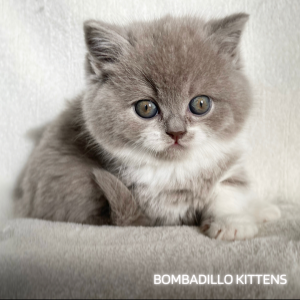Discover how we create beautiful British Shorthair kittens that meet the GCCF Standard of Points
We aim to breed British Shorthair kittens that will be perfect family pets. That means that all of our kittens should be as healthy as possible, and as happy and well socialised as possible. And of course, just happen to be absolutely stunning British Shorthairs too!
The approaches we take to promote healthy, happy, well socialised kittens are explored elsewhere. This article focuses on how we go about producing beautiful British Shorthair kittens that come as close to the perfect, chunky British Shorthair as possible, without straying into the realms of extreme cat breeds.
The GCCF Standard of Points for British Shorthairs lays out the way in which British Shorthair cats are judged at all GCCF shows. We consider these guidelines when assessing the strengths and weaknesses of all of our cats. Because each kitten will inherit half of its genetic material from its mother and half from its father, it is necessary to consider how the genetics of each parent will combine with each other.

The genetics of reproduction
The genetics of reproduction is an extremely complex, sophisticated and impressive process that is still not yet fully understood, although some excellent work has been done in the last few years to sequence the feline genome. This article does not seek to provide a thorough introduction to the genetics of feline reproduction, but simply to highlight the absolute basics required to understand what informs our choices when breeding beautiful British Shorthairs.
Chromosomes are the building blocks of a cat’s genetic make up. They exist in every cell and they always exist in pairs. In reproduction there is one exception to this: when a sperm or an egg is produced, one cell divides into two. So in a male, one male cell divides and creates two sperm. In a female one cell divides and creates two eggs. During this division, the pairs of chromosomes in the original cell split, and one of each pair goes into each of the two new sperm or eggs that are created. When the sperm and the egg combine, the chromosomes then pair up with each other, creating a new embryo with a new set of chromosome pairs.
This is why a cat can be blue, but also carry chocolate: it has one chromosome that codes for blue and another that codes for chocolate. Since the blue chromosome is dominant, that is the colour that we see. But the cat also carries chocolate, we just can't see it exhibited externally.
The genetics of breeding British Shorthair kittens
When we consider ideal matings, we try to consider all of the genes of each cat, including those we can’t see. Sometimes this is impossible, but if we have an understanding of the parents and grandparents of the cat it becomes much more possible. We look at the parents of the cat, and the grandparents to try and see as many of the cat's genes exhibited as we can.
Once we have the best understanding of the genes of each cat, we then move on to consider how those genes might match up: what sort of kittens they might create. Genetics is all about making good matches: matches that work together well. Then we try to make matches that emphasise and highlight the cat’s good points, whilst also strengthening the areas it scored less well in. It is also important not to create an 'overstrength'. For example, we want British Shorthair cats to be nice and chunky with big round faces, but if we breed two cats with extremely large, round heads we can end up with kittens that are too flat faced. So choosing a mating pair is about balance. Unfortunately, too often we see breeders combine cats that both have a desirable train in an extreme form, and that is what has led to the extremes of breeds like Persian cats. We are trying to avoid that with the British Shorthair, although we are beginning to see extreme examples of the breed, which is a great shame. As a breeder it is vital to consider balance. More of a good thing, or a desirable trait, is not always a good thing.
Genetics is not straightforward. Two cats with small ears can create a kitten with large ears - because they may each have a recessive gene that is not displayed, that can create big ears. This is why it is very useful to have an understanding and knowledge of the parents and grandparents of a cat. If a cat is capable of producing a kitten with big ears, the chances are that somewhere in its history there will have been at least one cat with big ears.
The 'Standard of Points'
Read about the GCCF Standard of Points. This is the document that all British Shorthairs are judged on at GCCF Shows. The GCCF have produced a Standard of Points for each cat breed that they recognise. If British Shorthairs are not your chosen breed, you can google your own and should find it easily. It is important to understand the Standard of Points for the breed you are interested in.
Read more...
If you would like to know more about how we create our Bombadillo kittens, you may like these articles:
- The life of a Bombadillo kitten that helps create our beautiiful little fur babies!
- Our philosophy
- Why all of our kittens are GCCF registered
- Should I choose a male or female kitten?
- Coronavirus in the cat population
British Shorthair breeders, based near Chester and Wrexham. We specialise in the more magical, unusual colours and patterns. Our articles are the result of many years of experience and research.